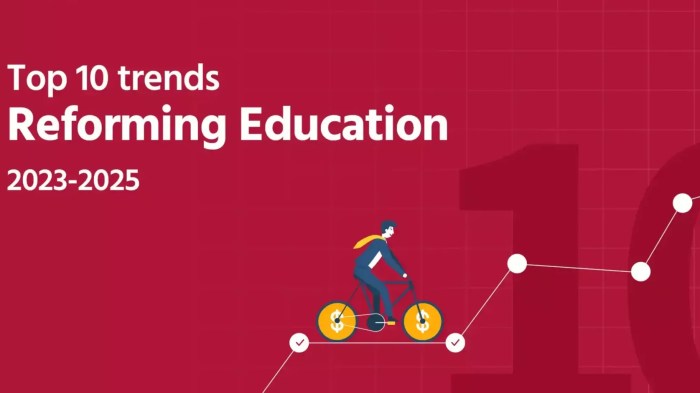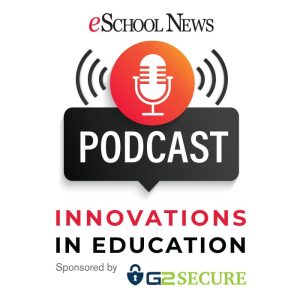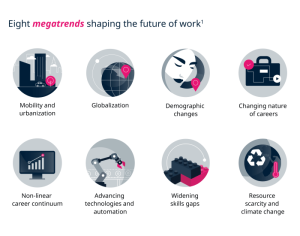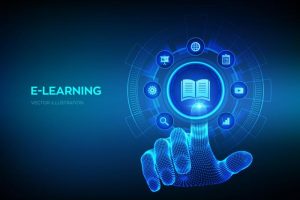
Distance education trends 2025 sets the stage for this enthralling narrative, offering readers a glimpse into a story that is rich in detail with entertaining interactive style and brimming with originality from the outset.
As we dive deeper into the world of distance education trends for 2025, we uncover a tapestry of technological innovations, personalized learning approaches, and global impacts that are reshaping the landscape of education as we know it.
Overview of Distance Education Trends 2025
Distance education, also known as online learning or e-learning, is a mode of education that allows students to learn remotely without being physically present in a traditional classroom setting. This method of learning utilizes technology such as the internet, video conferencing, and digital resources to deliver educational content to students.Forecasting trends for distance education in 2025 is crucial as it helps educational institutions, policymakers, and stakeholders anticipate changes in the field and adapt their strategies accordingly.
By identifying emerging trends, they can stay ahead of the curve and leverage new technologies and methodologies to enhance the quality of education and improve learning outcomes for students.
Key Factors Influencing the Evolution of Distance Education by 2025
- Rapid Technological Advancements: The rapid pace of technological advancements, such as artificial intelligence, virtual reality, and augmented reality, will continue to shape the landscape of distance education. These technologies will enable more immersive and interactive learning experiences for students.
- Personalized Learning: With the help of data analytics and machine learning algorithms, distance education platforms will be able to provide personalized learning experiences tailored to the individual needs and preferences of each student. This customization will enhance student engagement and improve learning outcomes.
- Globalization of Education: Distance education will break down geographical barriers and enable students from around the world to access high-quality education from top institutions. This globalization of education will lead to greater diversity in the classroom and foster cross-cultural collaboration.
- Accessibility and Inclusivity: Advancements in accessibility technologies and inclusive design practices will ensure that distance education platforms are accessible to students of all abilities. This will promote inclusivity and diversity in the online learning environment.
- Workforce Training and Upskilling: Distance education will play a crucial role in providing workforce training and upskilling opportunities to professionals seeking to enhance their skills or transition to new careers. Employers will increasingly rely on online learning platforms to train their employees and stay competitive in the rapidly changing job market.
Technological Advancements Shaping Distance Education

The integration of emerging technologies like AI, AR, and VR is revolutionizing the landscape of distance education, offering innovative ways to engage learners and enhance the overall learning experience. These technologies are not only making education more interactive but also providing personalized learning opportunities to students worldwide.
Role of Blockchain in Securing Online Learning Environments
Blockchain technology is playing a crucial role in securing online learning environments by providing a decentralized and tamper-proof system for storing academic records, certifications, and student data. Through blockchain, educational institutions can ensure the authenticity and integrity of online credentials, making the verification process more efficient and reliable.
IoT Devices Enhancing Remote Learning Experiences
IoT devices are transforming remote learning experiences by enabling seamless connectivity and communication between students and educators. These devices facilitate real-time collaboration, instant feedback, and personalized learning pathways, creating a dynamic and interactive virtual classroom environment. With IoT devices, students can access educational resources anytime, anywhere, and engage in immersive learning activities that cater to their individual needs.
Personalized Learning in Distance Education
Personalized learning in distance education refers to the use of adaptive learning algorithms to tailor educational experiences to the individual needs and preferences of each student. This approach enables students to progress at their own pace, focus on areas where they need more support, and receive targeted feedback to enhance their learning outcomes.
Adaptive Learning Algorithms
Adaptive learning algorithms use data analytics and artificial intelligence to analyze students’ performance and behavior. By tracking their interactions with the learning platform, these algorithms can identify areas of strength and weakness, and then adjust the content, pace, and difficulty level of the material to suit each student’s unique learning style.
- Adaptive learning algorithms gather data on students’ learning preferences, progress, and performance.
- Based on this data, the algorithms generate personalized learning paths for each student.
- These paths can include targeted exercises, additional resources, and customized feedback to help students master the material.
Impact on Student Engagement and Performance
Personalized learning paths have a significant impact on student engagement and performance in distance education. By providing tailored content and support, students are more motivated to learn and are better able to grasp complex concepts.
- Students are more likely to stay engaged and focused when the material is relevant to their individual learning needs.
- Personalized learning paths can boost student confidence and self-efficacy, leading to improved academic performance.
- By catering to students’ strengths and weaknesses, adaptive learning algorithms help reduce frustration and enhance the overall learning experience.
Strategies for Implementation
Implementing personalized learning in distance education platforms requires careful planning and coordination. Educators can use a variety of strategies to integrate adaptive learning algorithms effectively and maximize the benefits for their students.
- Provide training and support for teachers to help them understand how to use adaptive learning technology effectively.
- Collaborate with instructional designers to create personalized learning paths that align with the curriculum and learning objectives.
- Regularly monitor and assess students’ progress to ensure that the adaptive learning algorithms are helping them achieve their academic goals.
Accessibility and Inclusivity in Online Education

In the realm of distance education, ensuring accessibility and inclusivity for all learners, including those with disabilities, is crucial for providing equal opportunities for education. Designing online courses that cater to diverse learners and leveraging innovative technologies are key factors in promoting accessibility and inclusivity in remote learning environments.
Challenges in Ensuring Accessibility for Students with Disabilities
Students with disabilities face unique challenges in accessing online educational content. Some common obstacles include:
- Lack of compatibility with assistive technologies
- Unintentional barriers in course design
- Limited options for alternative formats
Importance of Designing Inclusive Online Courses for Diverse Learners
Creating inclusive online courses benefits all learners, not just those with disabilities. Some reasons why inclusive course design is important include:
- Promotes a positive learning environment
- Enhances engagement and retention
- Fosters a sense of belonging and community
Innovative Technologies Promoting Equal Access to Education
Advancements in technology have paved the way for greater accessibility in online education. Some innovative technologies that promote equal access to education in remote settings include:
- Speech-to-text and text-to-speech tools
- Screen readers and magnification software
- Virtual reality for immersive learning experiences
Future Skills Development through Distance Education
In today’s rapidly evolving job market, it is crucial for distance education programs to align with future workforce demands by equipping learners with the necessary skills to succeed in their careers. Let’s explore how distance education is shaping the development of future skills.
Role of Micro-credentialing and Digital Badges
Micro-credentialing and digital badges play a significant role in enhancing skill development in distance education. These bite-sized credentials allow learners to acquire specific skills and knowledge in a flexible manner, making them more competitive in the job market. By earning these digital badges, students can showcase their expertise and accomplishments to potential employers, providing tangible proof of their skill set.
- Micro-credentials offer targeted learning experiences that focus on specific competencies, allowing learners to upskill or reskill in high-demand areas.
- Digital badges provide a visual representation of an individual’s achievements, making it easier for employers to identify relevant skills and qualifications.
- Integration of micro-credentialing and digital badges in distance education programs encourages continuous learning and skill development, promoting lifelong learning among students.
Integration of Soft Skills Training
In addition to technical skills, soft skills are becoming increasingly important in today’s workforce. Distance education programs are now integrating soft skills training to help students develop essential competencies such as communication, teamwork, problem-solving, and adaptability. By incorporating soft skills training into online learning environments, students can enhance their employability and succeed in diverse work settings.
Soft skills are often referred to as “employability skills” as they are crucial for career success and professional growth.
- Online simulations, interactive activities, and virtual team projects are being used to provide practical experiences that help students develop soft skills in a virtual setting.
- Collaborative online platforms and communication tools enable students to practice effective communication, teamwork, and leadership skills in a digital environment.
- Soft skills training in distance education programs prepares students to effectively navigate the complexities of the modern workplace and adapt to changing job requirements.
Impact of Global Events on Distance Education Trends
The landscape of distance education has been significantly influenced by recent global events, particularly the COVID-19 pandemic. This unforeseen crisis has accelerated the adoption of online learning and reshaped the way educational institutions deliver instruction to students worldwide. As we look ahead to 2025, it is crucial to understand the lasting impact of these global events on distance education trends.
Acceleration of Online Learning Adoption
The COVID-19 pandemic forced educational institutions to quickly transition to online learning to ensure continuity of education. This sudden shift highlighted the importance of digital technologies in facilitating remote instruction and learning. As a result, many schools and universities have embraced online platforms and tools, leading to a rapid increase in the adoption of distance education.
- Online learning platforms such as Zoom, Google Classroom, and Moodle experienced a surge in users as schools shifted to remote teaching.
- Virtual classrooms and webinars became the new norm, providing students with a flexible and accessible way to continue their education.
- Educators and institutions had to adapt their teaching methods to suit the online environment, incorporating interactive elements and multimedia resources to engage students effectively.
Long-Term Implications of the COVID-19 Pandemic
The COVID-19 pandemic has highlighted the importance of resilience and adaptability in the education sector. Moving forward, the lessons learned from this crisis will shape distance education strategies and policies for years to come.
- Educational institutions may continue to offer hybrid learning models that combine in-person instruction with online components to enhance flexibility and accessibility.
- Investments in digital infrastructure and training for educators will be prioritized to ensure smooth transitions in case of future disruptions.
- Remote assessment and evaluation methods will be further developed to maintain academic integrity and ensure the quality of online education.
Geopolitical Factors Influencing Distance Education Trends
Geopolitical factors, such as government regulations, international relationships, and economic conditions, can also impact the direction of distance education trends by 2025. These factors play a significant role in shaping policies and initiatives that may either promote or hinder the growth of online learning globally.
- Countries with strong digital infrastructure and supportive policies for online education are likely to lead the way in advancing distance learning opportunities.
- International collaborations and partnerships between educational institutions across borders can foster innovation and knowledge exchange in the field of distance education.
- Economic challenges and disparities in access to technology may pose barriers to the widespread adoption of online learning, especially in developing regions.
EDUCATION AND REFERENCE EDUCATION AND TRAINING
Education and training play a crucial role in shaping the future of distance learning. As technology continues to advance and the digital education landscape evolves, educators need to continuously adapt and enhance their skills to meet the changing needs of students in online environments.
Professional Development Programs for Online Teaching
Professional development programs are essential for educators to stay abreast of the latest trends and best practices in online teaching. These programs provide teachers with the necessary tools and techniques to effectively engage students in virtual classrooms, create interactive learning experiences, and assess student progress in online settings.
- Professional development programs help educators develop skills in using various online teaching platforms and tools effectively.
- They also focus on strategies for managing online classroom dynamics, fostering student collaboration, and providing timely feedback.
- Continuous training through professional development programs enables educators to stay motivated, innovative, and responsive to the diverse learning needs of students in digital learning environments.
Continuous Learning and Upskilling for Educators
In the rapidly evolving digital education landscape, continuous learning and upskilling are imperative for educators to remain effective and relevant in their teaching practices. By engaging in lifelong learning opportunities, educators can enhance their pedagogical skills, integrate new technologies into their teaching, and adapt to emerging trends in distance education.
- Continuous learning helps educators stay current with advancements in educational technology, instructional design, and online teaching methodologies.
- Upskilling initiatives provide educators with the knowledge and expertise to create engaging, interactive, and personalized learning experiences for students in virtual classrooms.
- By upskilling, educators can effectively address the challenges of remote learning, promote student success, and foster a culture of lifelong learning among their students.
Closure
In conclusion, Distance education trends 2025 paint a vivid picture of the evolving educational sphere, where inclusivity, technological advancements, and global events converge to shape a future where learning knows no bounds. Get ready to embark on this transformative journey towards education in 2025 and beyond.
FAQ Section
How are emerging technologies like AI, AR, and VR transforming distance education?
These technologies are revolutionizing distance education by offering immersive learning experiences, personalized content delivery, and interactive simulations that enhance student engagement.
What is the significance of education and training in shaping the future of distance learning?
Education and training play a crucial role in preparing educators and students for the digital age, ensuring that they have the skills and knowledge needed to thrive in online learning environments.
How do recent global events impact distance education trends by 2025?
Global events like the COVID-19 pandemic have accelerated the adoption of online learning and are likely to influence the direction of distance education trends by 2025, emphasizing the need for flexibility and innovation in educational approaches.






